epw017640 ENGLAND (1927). The Portland Cement Works, Northfleet, 1927
© Copyright OpenStreetMap contributors and licensed by the OpenStreetMap Foundation. 2025. Cartography is licensed as CC BY-SA.
Nearby Images (17)
Details
| Title | [EPW017640] The Portland Cement Works, Northfleet, 1927 |
| Reference | EPW017640 |
| Date | April-1927 |
| Link | |
| Place name | NORTHFLEET |
| Parish | |
| District | |
| Country | ENGLAND |
| Easting / Northing | 562028, 174843 |
| Longitude / Latitude | 0.33202780456314, 51.448869420678 |
| National Grid Reference | TQ620748 |
Pins
 Dylan Moore |
Monday 12th of July 2021 12:27:37 PM | |
 Dylan Moore |
Monday 12th of July 2021 12:26:25 PM | |
 Dylan Moore |
Tuesday 5th of June 2018 11:12:50 PM | |
 Dylan Moore |
Tuesday 5th of June 2018 11:11:38 PM | |
 Dylan Moore |
Tuesday 5th of June 2018 11:10:26 PM | |
 Dylan Moore |
Tuesday 5th of June 2018 11:09:22 PM | |
 Dylan Moore |
Tuesday 5th of June 2018 11:07:10 PM | |
 Dylan Moore |
Tuesday 5th of June 2018 11:05:40 PM | |
 Dylan Moore |
Tuesday 5th of June 2018 11:05:02 PM | |
 Dylan Moore |
Tuesday 5th of June 2018 11:04:15 PM | |
 Dylan Moore |
Tuesday 5th of June 2018 11:02:01 PM | |
 Dylan Moore |
Tuesday 5th of June 2018 11:00:39 PM | |
 Dylan Moore |
Tuesday 5th of June 2018 10:59:25 PM | |
 ladyceecee |
Sunday 21st of August 2016 04:34:35 PM | |
 Dylan Moore |
Thursday 3rd of December 2015 02:09:09 PM | |
 Dylan Moore |
Friday 25th of January 2013 10:21:57 PM | |
 Dylan Moore |
Tuesday 16th of October 2012 01:43:05 PM | |
 Dylan Moore |
Tuesday 16th of October 2012 01:42:42 PM |
User Comment Contributions
James Parker, a clergyman and cement manufacturer developed Roman or 'natural' cement in the 1780s at his plant at Northfleet Creek, Kent in response to the need to produce a product which had a fast drying time. His patent for the material in 1796 described the product as 'A certain Cement or Terras to be used in Aquatic and other Buildings and Stucco Work'. It was nothing like the cement used by the Romans, the name was possibly adopted because of its quick-drying properties, as concrete used by the Romans also enabled them to build their dock walls under water. Parker used naturally occurring clay-rich limestone found as nodules in the London clay deposits on the Isle of Sheppey. The nodules were burnt and then ground to a fine powder which, when made into mortar with sand and water, set in 5 to 15 minutes. For the grinding process Parker may have used an ancient tidal water mill at the head of the creek or a nearby windmill. 'Natural' cement from Parker's Northfleet works was used in the decoration for the Neo Gothic folly Hadlow Tower, Hadlow, Kent (now a Grade 1* Listed Building). The same cement was used during its restoration (2010-2013) but had to be imported from Grenoble, France as it is no longer made in the UK. Info from 'Hadlow Castle, Creation & Restoration' 2015. |
 ladyceecee |
Sunday 21st of August 2016 05:01:45 PM |
 Dylan Moore |
Tuesday 16th of October 2012 08:37:01 PM | |
Picture of APCM's Bevans Cement Plant . The plant had been shut down in 1921 for a complete re-build, and the first of the three new kilns was lit up on 23/03/1926. When the third kiln was lit in the following August, it became Britain’s largest plant. A fourth kiln was installed at the end of 1928. The plant shut down in 1970 when it was replaced by the adjacent Northfleet plant. The slurry was made at a quarry 1 km to the southwest and was pumped to the mixers shown. The abandoned slurry "backs" used in the nineteenth century plant are still in place. The deep water wharf was a major part of the new project, and the plant was reserved mainly for exports. |
 Dylan Moore |
Tuesday 16th of October 2012 08:35:48 PM |


![[EPW017640] The Portland Cement Works, Northfleet, 1927](http://britainfromabove.org.uk/sites/all/libraries/aerofilms-images/public/100x100/EPW/017/EPW017640.jpg)
![[EPW060578] The Bevan Portland Cement Works, Northfleet, 1939](http://britainfromabove.org.uk/sites/all/libraries/aerofilms-images/public/100x100/EPW/060/EPW060578.jpg)
![[EPW017639] The Portland Cement Works, Northfleet, 1927](http://britainfromabove.org.uk/sites/all/libraries/aerofilms-images/public/100x100/EPW/017/EPW017639.jpg)
![[EPW060577] The Bevan Portland Cement Works and environs, Northfleet, 1939](http://britainfromabove.org.uk/sites/all/libraries/aerofilms-images/public/100x100/EPW/060/EPW060577.jpg)
![[EPW017638] The Portland Cement Works, Northfleet, 1927](http://britainfromabove.org.uk/sites/all/libraries/aerofilms-images/public/100x100/EPW/017/EPW017638.jpg)
![[EPW060579] The Bevan Portland Cement Works, Northfleet, 1939](http://britainfromabove.org.uk/sites/all/libraries/aerofilms-images/public/100x100/EPW/060/EPW060579.jpg)
![[EPW060573] The Bevan Portland Cement Works, Northfleet, 1939](http://britainfromabove.org.uk/sites/all/libraries/aerofilms-images/public/100x100/EPW/060/EPW060573.jpg)
![[EPW017644] The Portland Cement Works, Northfleet, 1927](http://britainfromabove.org.uk/sites/all/libraries/aerofilms-images/public/100x100/EPW/017/EPW017644.jpg)
![[EPW017641] The Portland Cement Works, Northfleet, 1927](http://britainfromabove.org.uk/sites/all/libraries/aerofilms-images/public/100x100/EPW/017/EPW017641.jpg)
![[EPW017643] The Portland Cement Works, Northfleet, 1927](http://britainfromabove.org.uk/sites/all/libraries/aerofilms-images/public/100x100/EPW/017/EPW017643.jpg)
![[EPW060572] The Bevan Portland Cement Works, Northfleet, 1939](http://britainfromabove.org.uk/sites/all/libraries/aerofilms-images/public/100x100/EPW/060/EPW060572.jpg)
![[EPW060583] The Bevan Portland Cement Works and the surrounding industrial area, Northfleet, 1939](http://britainfromabove.org.uk/sites/all/libraries/aerofilms-images/public/100x100/EPW/060/EPW060583.jpg)
![[EPW060576] The Bevan Portland Cement Works, Northfleet, 1939](http://britainfromabove.org.uk/sites/all/libraries/aerofilms-images/public/100x100/EPW/060/EPW060576.jpg)
![[EPW017642] The Portland Cement Works, Northfleet, 1927](http://britainfromabove.org.uk/sites/all/libraries/aerofilms-images/public/100x100/EPW/017/EPW017642.jpg)
![[EPW060580] The Bevan Portland Cement Works and the surrounding industrial area, Northfleet, 1939](http://britainfromabove.org.uk/sites/all/libraries/aerofilms-images/public/100x100/EPW/060/EPW060580.jpg)
![[EPW017645] The Portland Cement Works, Northfleet, 1927](http://britainfromabove.org.uk/sites/all/libraries/aerofilms-images/public/100x100/EPW/017/EPW017645.jpg)
![[EPW060575] The Bevan Portland Cement Works and environs, Northfleet, 1939](http://britainfromabove.org.uk/sites/all/libraries/aerofilms-images/public/100x100/EPW/060/EPW060575.jpg)
